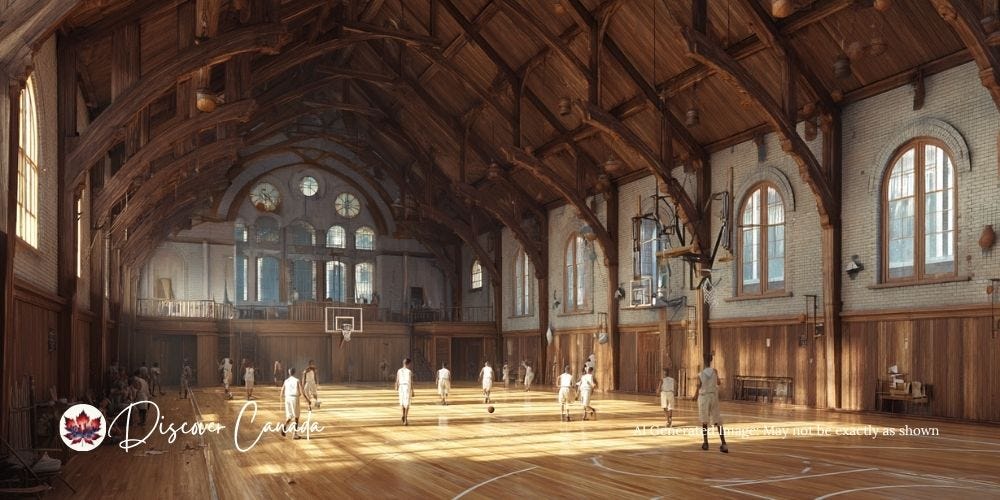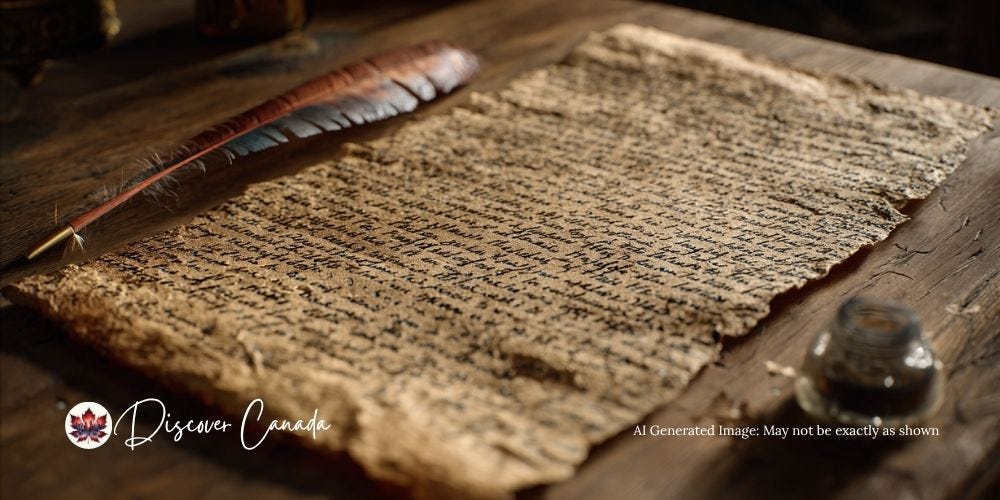From Rocks to Rims: The Surprising Birth of Basketball
Discover how a 30-year-old Canadian teacher changed the world with two peach baskets.

🎧 Listen While You Read
Hit play and hear how a Canadian kid with a rock invented one of the world’s greatest games — and why it all started with boredom, winter, and a little imagination.
🏀 The Rock That Became Basketball: How a Canadian Kid Changed the Game
🌟 Introduction — From Rocks to Rims
You know basketball, right? Fast breaks. Slam dunks. Million-dollar sneakers.
But it all started… with a rock.
In the chilly fields of Almonte, Ontario, a ten-year-old named James Naismith used to play a game called Duck on a Rock. The rules were simple — throw one stone to knock another off a big boulder: no hoop, no crowd, just friends, laughter, and the arc of a perfect throw.
Twenty years later, that same kid was now a 30-year-old physical education instructor at the YMCA Training School in Springfield, Massachusetts. One December day in 1891, he was handed an impossible task: invent a new indoor game that wouldn’t break bones or windows.
He thought back to those stones. The aim. The arc. The thrill of precision.
And with that memory — two peach baskets, a soccer ball, and a scrap of paper with 13 rules — basketball was born.
🗝️ Key Takeaways
🏀 A Canadian invention — Basketball was created by James Naismith, a 30-year-old gym teacher from Ontario, in Springfield, Massachusetts in 1891.
🪨 Inspired by childhood play — The game Duck on a Rock from his youth in Almonte, Ontario, gave Naismith the idea for the perfect arc — and the foundation of the jump shot.
🥇 From humble to historic — Two peach baskets, one soccer ball, and a janitor with a ladder turned into a global sport played by over 450 million people today.
🪨 Duck on a Rock — The Game That Sparked a Revolution
🎯 A Simple Childhood Game
Long before there were crowds, sneakers, or shot clocks, there was Duck on a Rock.
On chilly afternoons in Almonte, Ontario, a young James Naismith and his friends would gather around a large boulder, laughing and competing in a game that was part skill, part luck, and all Canadian ingenuity.
The “duck” was a larger stone balanced on top of a rock.
Each player tried to knock it off by tossing their own smaller stone.
The trick? You couldn’t throw straight or hard — you had to arc your shot just right.
It was target practice meets teamwork — a perfect playground for imagination.
🧠 The Seed of a Global Sport
What that ten-year-old didn’t know was that this game — born of boredom and winter — would stick with him for life.
He learned that power might win a moment, but accuracy wins the game.
That graceful arc — a stone through the cold air — would one day define the art of the basketball jump shot.
From a frozen field in rural Ontario, the first idea of basketball was quietly set in motion.
🧑🏫 The 30-Year-Old Teacher and the Winter Problem
🥶 A Challenge in Springfield
Fast forward twenty years. The boy with the stones is now Dr. James Naismith, a 30-year-old physical education instructor at the International YMCA Training School in Springfield, Massachusetts.
It’s the winter of 1891, and his supervisor, Dr. Luther Gulick, gives him an assignment that sounds simple — but isn’t:
“Invent a new indoor game that keeps students active… without breaking bones, windows, or each other.”
The football players were too rough. The gym was too small. And the New England winter seemed endless.
💡 Inspiration Strikes
Naismith wanted something fast-paced but safe — a game that tested skill, not strength.
And then, somewhere between frustration and memory, he remembered that old Ontario game.
The arc, the aim, the satisfaction of a perfect hit — Duck on a Rock had taught him that finesse could be more powerful than force.
So he started sketching ideas for a game where players scored by throwing a ball into a goal above their heads, not by colliding on the floor.
It was a small spark of creativity that would soon ignite a global passion.
And in that moment, a Canadian teacher reimagined how the world would play.
🏀 Two Peach Baskets, a Soccer Ball, and a Janitor
🧺 The Birth of Basketball
By mid-December 1891, James Naismith had sketched his new game. All he needed were a few supplies — and a little luck.
He sent a janitor to find something — anything — that could serve as a goal.
The janitor returned with two old peach baskets, and Naismith nailed them to the balcony railing at opposite ends of the gym.
Equipment: one soccer ball
Goals: two peach baskets
Team size: nine players on each side (because that’s how many showed up)
No one thought to cut holes in the bottoms, so after every basket, the janitor had to climb a ladder to retrieve the ball.
That first game looked nothing like the one we know today — more soccer than slam dunk. But the energy was electric. For the first time, competition met creativity in the same breath.
“The boys seemed to enjoy it,” Naismith later wrote. “And thus, the game of basketball was born.”
📜 Thirteen Rules and a World in Motion
🧠 The Blueprint for a Revolution
Once James Naismith nailed up his peach baskets, he needed a framework — something to keep this new game from descending into chaos.
So, in December 1891, he jotted down 13 simple rules on a scrap of paper.
They weren’t written for fame. They were written to survive the next gym class.
Here they are — the original laws of the court:
The ball may be thrown in any direction with one or both hands.
The ball may be batted in any direction with one or both hands (never with the fist).
A player cannot run with the ball. They must throw it from the spot where they catch it.
The ball must be held in or between the hands; arms or body cannot be used to hold it.
No shouldering, holding, pushing, striking, or tripping an opponent.
A foul is striking at the ball with the fist, or violating Rules 3, 4, or 5.
If either side makes three consecutive fouls, the opponents get a goal.
A goal is made when the ball is thrown or batted into the basket and stays there.
When the ball goes out of bounds, it’s thrown back into play by the first person to touch it.
The umpire keeps track of fouls and notifies the referee when three consecutive fouls occur.
The referee judges the ball and decides when it’s in play, in bounds, and to whom it belongs.
The time shall be two 15-minute halves, with a five-minute rest between.
The side making the most goals in that time shall be declared the winner.
🏀 A Simpler Game, a Deeper Purpose
It wasn’t flashy — no dribbling, no dunking, no three-pointers.
But in those 13 lines, Naismith created the DNA of a global sport.
He’d solved his problem: a game that rewarded skill, accuracy, and cooperation over aggression.
The students loved it. The noise echoed down the hallways of the YMCA. And before long, the world started listening too.
“The boys seemed to enjoy it,” he wrote modestly. “And thus, the game of basketball was born.”
🌍 The Spread of an Idea
Within weeks, the game spread through the YMCA network. Within months, it reached Canada, Europe, and Asia.
By the time Naismith realized what he’d unleashed, basketball had bounced far beyond Springfield.
And true to his humble nature, he never patented it — he believed the game belonged to everyone.
“I knew it would spread,” he once said, “but I never dreamed it would go this far.”
🍁 A Game That Bounced Home
🇨🇦 Canada’s Role in Basketball’s First Chapter
When James Naismith mailed his new game’s rules to colleagues around North America, it didn’t take long for the idea to come home.
Through the YMCA network, basketball quickly crossed the border — carried by Canadian instructors who saw its potential.
Among them was J. Howard Crocker, a fellow Canadian who introduced basketball to Nova Scotia and helped standardize its early rules.
Within a few short years, gymnasiums from Montreal to Winnipeg echoed with the thump of soccer balls and the laughter of players learning the art of the arc.
🧭 The Humble Inventor
And what about Naismith himself?
He never patented the game. Never charged a fee. Never cashed in on what would become a billion-dollar sport.
“Basketball doesn’t belong to me,” he once said. “It belongs to anyone who plays it.”
That humility — and that generosity — might be the most Canadian part of the story.
🌍 From Humble Beginnings to Global Phenomenon
🌐 A Sport That Conquered the World
In 1891, there were eighteen students and two peach baskets.
Today, there are over 450 million players in 200 countries.
The game Naismith created to fill a cold winter afternoon now fuels Olympic dreams, billion-dollar franchises, and street courts from Toronto to Tokyo.
💬 A Touch of Humour
Somewhere out there, that original rock in Almonte is probably still lying in a field, thinking,
“I really peaked too soon.”
From a backyard game to a global language of motion, teamwork, and precision, basketball became proof that small ideas can change the world.
🇨🇦 The Canadian Who Changed the Game
🧭 A Modest Visionary
For all that he created, James Naismith never saw himself as a visionary.
He didn’t chase fame or fortune. He chased a balance between competition and character.
Before basketball, he’d studied theology and physical education, believing that sports could build both the body and the spirit. His goal wasn’t to create stars — it was to create better people.
“Basketball,” he said, “is not a game for the selfish.”
Even as the sport exploded worldwide, Naismith stayed humble.
He later became the first basketball coach at the University of Kansas, though he’s the only one in the program’s history with a losing record — and he was perfectly fine with that.
💬 A Canadian Legacy
It’s almost poetic, really.
A Canadian invents one of the world’s most exciting sports… then politely lets everyone else run with it.
It’s innovation wrapped in humility — the most Canadian origin story imaginable.
🪨 Final Bounce — Lessons from a Rock
💡 What It Really Means
From a rock in Almonte, Ontario, to a gym in Springfield, Massachusetts, basketball’s story is more than a history of sport — it’s a story of creativity, simplicity, and heart.
It reminds us that small ideas can have a global impact.
The best innovations often come from constraints, not comfort.
And that play — pure, curious, joyful play — is one of humanity’s greatest teachers.
🏀 Closing Thought
So next time you watch an NBA game, remember this:
Every perfect shot, every buzzer beater, every roar of the crowd — it all traces back to a ten-year-old Canadian throwing a stone at a rock.
Sometimes, greatness starts with a single toss.






